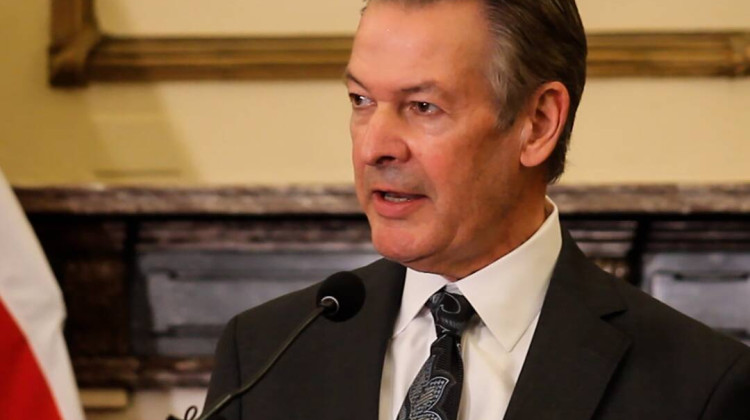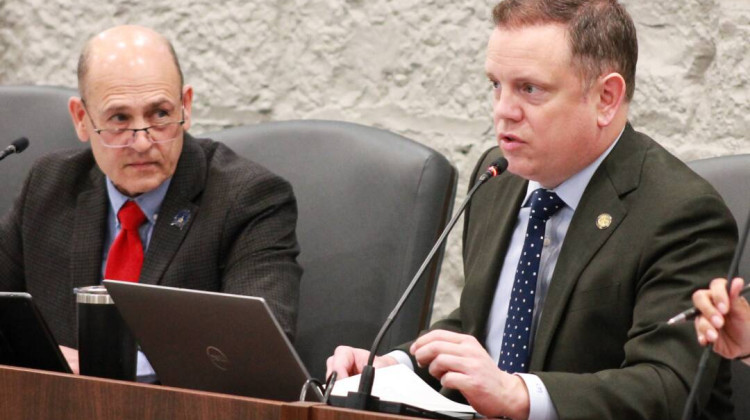
The biennium budget covers state agencies, boards, commissions, departments and the programs they oversee, capital projects and public education for two fiscal years.
Lauren Chapman/IPB NewsIndiana lawmakers will write the two-year budget this session – a document of their policy priorities, more than 200 pages long, that will spend more than $37 billion.
The biennium budget covers state agencies, boards, commissions, departments and the programs they oversee, capital projects and public education for two fiscal years.
How is the state budget created?
Pre-session:
The budget process actually begins the year before the long legislative session starts, with the State Budget Agency, or SBA, providing instructions for agencies to submit their budget requests. Those budget requests include the operating costs of the agencies and any requests to expand the services provided by those agencies.
Those budget requests are reviewed by the SBA and it makes recommendations for lawmakers on the State Budget Committee. The committee holds public hearings with state agencies and public university leaders to review their requests before it and the SBA create the budget report and a first draft of the state budget. Both of those documents create an itemized budget for each state agency, office, board, commission and department. That report and draft bill is submitted to the governor, who then delivers it to the General Assembly.
During the legislative session:
The draft bill is assigned and introduced to the House Ways and Means Committee and follows a similar process to other bills moving through the Statehouse. There are public hearings for public agencies and stakeholders to testify on the budget. The House majority caucus (in Indiana, Republicans) then introduce their version of the budget, which becomes the budget bill. The House Ways and Means Committee may make further amendments to the proposed budget during the process and then send it to the full House for its second reading.
On second reading, more amendments may be made to the proposed budget. And on third reading, lawmakers will vote to send it to the Senate.
In the Senate, the proposed budget is assigned and introduced to the Senate Appropriations Committee, where it follows an identical process from the House. The Senate majority caucus (again, Republicans) unveil their own version of the proposed budget, which is incorporated as an amendment to the bill.
Once both chambers agree on the language of the budget, it’s sent to the governor for their signature.
Who writes the budget?
Technically, a lot of people have their hands on the budget. But after the recommendations are sent to lawmakers, the chairs of the House Ways and Means Committee and the Senate Appropriations Committee become the architects of the budget.
Indiana House Republicans have a new budget architect, 12-term Rep. Jeff Thompson (R-Lizton). In the Senate, Sen. Ryan Mishler (R-Mishawaka) is the chair of the Appropriations Committee.
How do I find a breakdown of the budget?
Initially, there isn’t really a better option than going through the budget bill itself. To find it, go to iga.in.gov/legislative/2023/bills/. Per the Indiana Constitution, the state budget must originate in the House. It is always the first bill on the list, HB 1001.
After clicking on that bill, you’ll go to the bill’s page. It will give you an introduction to the bill and list some information about what is in it. On the left side of the page is a menu, click on “Latest version.” The PDF will be long, but it will contain a breakdown under each agency or department.
Eventually, after passage, there are easier breakdowns of agency, category, etc. – including the Indiana Transparency Portal.
Most taxes go into the state General Fund. That’s where the vast majority of funding for the budget comes from. A notable exception are gas taxes, which are specifically allocated for road funding.
READ MORE: How do I follow Indiana’s legislative session? Here’s your guide to demystify the process
Join the conversation and sign up for the Indiana Two-Way. Text "Indiana" to 73224. Your comments and questions in response to our weekly text help us find the answers you need on statewide issues and throughout the legislative session.
How long has Indiana had a budget surplus? How much is left after the taxpayer refunds and inflation relief?
First, it’s important to differentiate between a budget surplus and budget reserves. A surplus is how much more money the state collected in a single fiscal year than it spent. Indiana almost always ends its fiscal years with a surplus. Notable exceptions are during economic downturns, like the Great Recession.
Surpluses are also frequent because the Indiana Constitution bars the legislature from enacting a law that creates debt, with few exceptions. And lawmakers doubled-down on that constitutional limit to their budgeting power a few years ago with a constitutional amendment (approved by the voters in 2018) that requires a balanced budget – unless two-thirds each of the House and Senate vote to override that requirement.
Budget reserves are money Indiana keeps in its coffers for emergency situations (for instance, during the Great Recession). There are actually four different reserve accounts: the General Fund reserve, the tuition reserve, the Medicaid reserve and the Rainy Day fund.
The General Fund reserve is the largest – Indiana ended its fiscal year in June 2022 with $4.5 billion in just that reserve account. Combined with the other accounts, Indiana’s reserves stood at $6.1 billion. That’s more than 28 percent of its operating budget, a considerably higher number than usual. Typically, reserves are 10-15 percent of the budget. Reserves were recently higher because of a few factors – the federal stimulus dollars that flowed not just to the state but to individuals, which led to more spending, which led to higher revenues. Inflation also helps state coffers by driving up sales tax revenues. And the economy has been strong, helping individual and corporate income taxes.
Strong reserve accounts help protect the state against deep budget cuts during an economic downturn (though not completely, as public schools can attest from the Great Recession). They also help the state maintain a triple-A credit rating from major credit agencies. That credit rating helps keep rates low when the state or local governments take out bonds in order to pay for projects.
Will there be any relief for income or property taxes in this upcoming budget?
Republicans have said they'll explore new tax cuts in the upcoming session, including potential property tax reform.
The revenue forecast says for the new state budget, Indiana is projected to increase revenue by a two-year total of $1.2 billion – even with a mild recession predicted next year. State agencies have requested about $700 million in new funding and the budgets for construction projects have increased because of inflation.
But Sen. Ryan Mishler (R-Bremen) said that doesn’t change GOP plans to explore new tax cuts.
"If you want to cut the revenue, then you're going to have [to] cut the spending," Mishler said. "So, I guess, we just have to put our priorities out there to see where we're going to be and balance it out."
What percent of total tax revenue from tobacco (state and federal) is used for tobacco prevention and cessation?
Indiana’s tobacco use prevention and cessation programs are paid for by the Tobacco Master Settlement Agreement. That agreement was made in 1998 between the country’s four largest tobacco companies and 52 state and territory attorneys general, to resolve lawsuits that many of the states had filed against the tobacco companies. As part of that agreement, the companies send each state money, every year, as long as they continue to sell cigarettes in this country.
In the current state budget, Indiana allocated $7.5 million each year for tobacco cessation and prevention from the master settlement agreement fund.
Contact reporter Brandon at bsmith@ipbs.org or follow him on Twitter at @brandonjsmith5. Contact Lauren at lchapman@wfyi.org or follow her on Twitter at @laurenechapman_.
9(MDAyMzk1MzA4MDE2MjY3OTY1MjM5ZDJjYQ000))
 DONATE
DONATE








 Support WFYI. We can't do it without you.
Support WFYI. We can't do it without you.